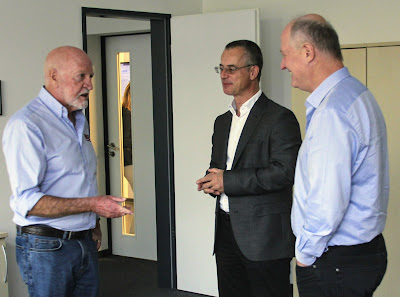I am writing this on the train from Bristol to Cornwall, after attending lectures on nuclear fusion last night at Bristol University.
Fusion will undoubtedly be the energy source of the future, but how far in the future is far from certain, as the engineering of fusion reactors is formidable and is only slowly becoming overcome. Containing a plasma of deuterium and tritium, isotopes of hydrogen, at temperatures of around 150 million degrees is an obvious challenge. Tritium also presents its own challenge, as, although deuterium is practically inexhaustible due to its presence in our oceans, the heavier tritium is radioactive, decaying with a half-life of 12.3 years, which explains its almost natural lack of existence. In fact, the natural tritium abundance is only around 3.5 kg, so it has to be "bred" in the fusion reactor by the fission of lithium isotopes.
Fusion will undoubtedly be the energy source of the future, but how far in the future is far from certain, as the engineering of fusion reactors is formidable and is only slowly becoming overcome. Containing a plasma of deuterium and tritium, isotopes of hydrogen, at temperatures of around 150 million degrees is an obvious challenge. Tritium also presents its own challenge, as, although deuterium is practically inexhaustible due to its presence in our oceans, the heavier tritium is radioactive, decaying with a half-life of 12.3 years, which explains its almost natural lack of existence. In fact, the natural tritium abundance is only around 3.5 kg, so it has to be "bred" in the fusion reactor by the fission of lithium isotopes.
Last night's young researchers from the UKAEA were a little cautious when I asked them when they felt that there might be fusion reactors in the UK feeding the National Grid, or smaller units serving local communities, but they were fairly confident that this would happen by the middle of the century, a little ironic maybe as this is only 30 years away and there has been a long-standing "joke" that fusion is only 30 years away- and always will be.
Our expert on this subject, British Prime Minister Boris Johnson, is, however, less cautious, and he told the Conservative party conference earlier this month "They (UK scientists) are on the verge of creating commercially viable miniature fusion reactors for sale around the world. "I know they have been on the verge for some time,” he continued, “It is a pretty spacious kind of verge.” But now, he assured his audience, “we are on the verge of the verge."
 |
| A prototype compact fusion reactor being developed by Tokamak Energy in UK who believe that these will be on sale by 2040 |
Well, having clarified that it is interesting to speculate what the future might hold, although predicting the future is virtually impossible. Thirty years ago the internet was in its infancy, having been invented 6 months previously, but it would be another year before the World Wide Web became universally used. Personal computers hadn't been around for long, smart phones and SatNavs were unheard of, and we were still taking pictures on photographic film.
But let's look 30 years ahead, to 2050, as the UN Paris Agreement demands that humanity must reach net zero greenhouse gas emissions by the middle of this century and former British Prime Minister Theresa May has committed the UK to attain this goal by 2050, making Britain the first major economy to do so.
In the posting of 21st July I suggested that zero carbon was unattainable if all vehicles driven by fossil fuel were replaced by electric vehicles, as there simply would not be a sufficient supply of raw materials to satisfy the demand. But what if there were fewer cars on the roads in 2050, far, far fewer in fact? Wouldn't that be wonderful? No more polluted and gridlocked towns and cities, with open space to walk, cycle and breathe the clean outdoor air.
How would this be possible? Last night in Bristol I was reminded of the efficiency and speed of Uber, the taxi service responding to a simple request by its smart phone app. Uber, however, is far from ubiquitous, being confined to relatively few major cities around the world. But it is not too outlandish to predict that by mid-century Uber-like taxi services will be everywhere, cities, towns and villages. And it is also a fair prediction that by then all cars will be driverless. Travel would be safe and stress-free, driverless taxis whisking you to your destination, before moving to the nearest charging point to await the next call.
In this world there would be little incentive for owning a private car, with all the associated hassle of insurance, maintenance etc, and inter-city travel would be by electric trains, and buses travelling on time and speedily on roads uninhibited by congestion.
And what about a world powered by nuclear fusion? How would this change the world we live in? It would certainly revolutionise industries, particularly mining, the world's most important industry and one of the most energy intensive.
There is one certainty about 2050 and that is that I will not be around to see it, so here's a question for all the young people out there who are involved with mineral processing, the most important technology within the crucial mining industry. How will limitless, cheap energy change the way we process ores? Copper for instance has to be comminuted and then upgraded by flotation before the energy intensive process of smelting. Would there be a need for the processing stage, which incurs losses to tailings, or would direct smelting be the preferred route? Would mineral processing have only a minor role in the mining industry, relegated to the production of industrial minerals only?
This is an area open to interesting discussion. Let's have your views.



















































